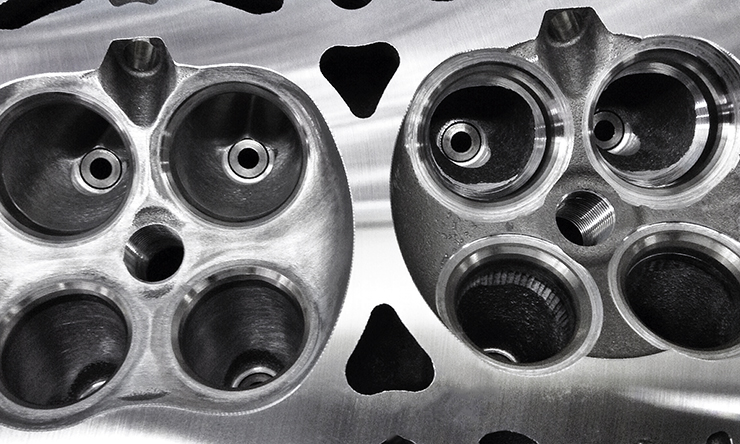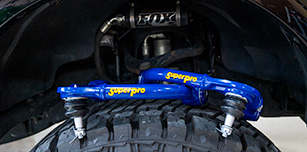Photos Courtesy: HeadGames Motorworks
The 2.3-liter Ford EcoBoost engine is one of the company’s first ventures into the world of direct fuel injection, but more importantly, it uses four-valve-per-cylinder, overhead-camshaft technology that it considered state of the art today. HeadGames Motorworks’ proprietor David Localio has years of successful development programs under his belt with all types of cylinder head castings, working with some of the quickest and fastest racers in the world to better their engine performances through meticulous research and testing processes.
Localio, who studied airflow and engine building technology at the School of Automotive Machinists, then worked in the cylinder head development department at Pat Musi Racing Engines. He founded HeadGames Motorworks in 2001; initially the company had a strong focus on domestic cylinder head development, and today, the company has cylinder heads on nearly every combination in competition and has dedicated years to honing their craft. So when the EcoBoost program came to be, and news spread of its inclusion into the 2015-and-newer Ford Mustang, Localio immediately sourced cylinder heads to begin testing the airflow capabilities and limits of the design.
Immediately, the intake side of the cylinder head became a concern.
“The cylinder head has a divider on the intake side that makes the cylinder head into two intake ports, and a lot of people are making it into a fin, and narrowing it, or knocking it back, then when they are making intake manifolds, they’re not doing that – there’s no divider there in the intake. It appears to me that they want the intake to be open, and big, and look really cool, but it does not work. It just kills the port. That’s the first thing I flowed – I made the fin, then put it onto the flowbench to test it, and it killed the flow. It was down 40 cfm,” says Localio.
The custom valve seat angles were determined after many hours of flow testing.
“I chased that for a good six to seven months, why it lost the flow. I did it in different ways, different lengths, and tried different valve jobs. I worked together on it with some colleagues at McLaren, who have a ton of experience in multi-valve engines, and we did flow testing both here and there with a velocity probe inside. We found that when we altered the divider, it moved all of the air to the upper right-hand side of the port, so it killed the left port, and made the right port the primary port, and only in that one area.”
The port is designed to be a tumble-port design by Ford, and when the divider is altered improperly, the cylinder head doesn’t perform as required, especially in a big-power application like the record-setting Mustang of Brad Gusler (featured here), which wears one of HeadGames’ fully-ported EcoBoost cylinder heads atop its Custom Performance Engineering-built shortblock, and just recently became the first EcoBoost Mustang racer to break the 9-second quarter-mile barrier.

The HeadGames-modified cylinder head from Brad Gusler’s Mustang.
Localio explains that there is a lot of power to be found with a properly-engineered pocket-port into the port throats – 70 cfm, in fact. The HeadGames pocket-port goes .200-inch deep into the port area; the shape is achieved by knocking out the valve guides and contouring the valve throat area before installing new, proprietary radiused bronze valve guides from GSC Power Division that have been designed to his specifications, seen in the photo below.
“We take the guides out and then port down into the head so we can work without the guide in the way, then install the new guides. You’re leaving some performance on the table by leaving them in during the porting process,” he explains.

The custom HeadGames Motorworks proprietary valve guides use radiused edges for improved airflow characteristics.
The EcoBoost cylinder head has many challenges on the exhaust side of the cylinder head. Not only is the cylinder head surface extended to create an exhaust manifold of sorts, but Localio says the water jackets are extremely close to the casting surface at the entrance. This has the effect of limiting the amount of port cleanup which can be done on the exhaust side of the cylinder head, but he also tells us that it doesn’t affect the performance of the cylinder head as much as one might think.

The water jacket area is extremely close to the head surface as seen in this development photo.
When the EcoBoost engine was first released for this car, the HeadGames Motorworks team worked hand-in-hand with Geoff Raicer of Full-Race to develop a bolt-on exhaust manifold for that company’s turbo kits.
“We went through many iterations of that design, which made us look at the exhaust port in a different way to determine how the manifold would react to it. We ended up making the manifold down almost to the factory size; because the shape of the port changes so much that it just didn’t work with the manifold itself. By shrinking the port side on the cylinder head, there was much more flow velocity. Bigger isn’t always better. You can’t go into the port because of the way it’s shaped – there’s just no way to reach it. From what we’ve learned, there’s really nothing to be had at the exit where the flow goes into the turbo. You get to a point of diminishing returns, and potentially lose reliability due to the thin-wall casting in that spot,” says Localio.
Left: The cylinder head on display at PRI in the Ferrea booth. Left Middle: Cutting valve seats. Right Middle: The custom valve spring package from HeadGames Motorworks. Right: The 2.7-liter EcoBoost head currently in development.
As Ford worked for many thousands of hours to perfect the orientation of the direct-injection location, HeadGames doesn’t touch it – they smooth around it, clean up any rough edges, and move to the rest of the combustion chamber, where power can be found in other ways. The gains to be achieved depend upon the combination and the level of aggressiveness desired by the customer, but unshrouding the valves, reshaping the chamber, and contouring it to accept more timing and boost is possible.
HeadGames has developed this combination of EcoBoost products for the 2.3-liter four-cylinder engine, but won’t stop here with the EcoBoost platform; Localio and his team have the port designs already developed for the 3.5-liter V6 EcoBoost (see above right) with the 2.7-liter EcoBoost cylinder head currently in development.


















